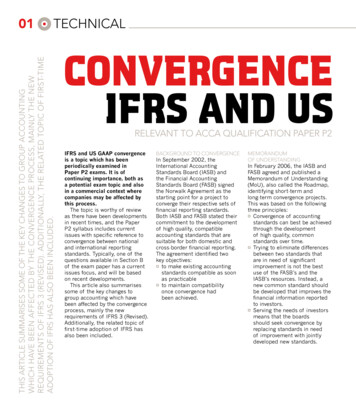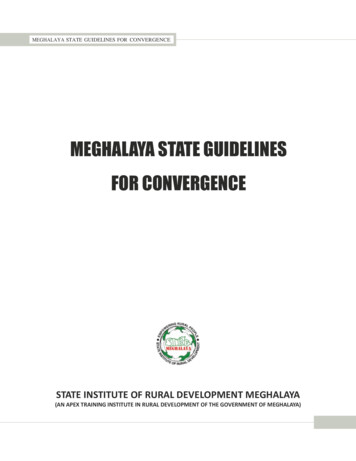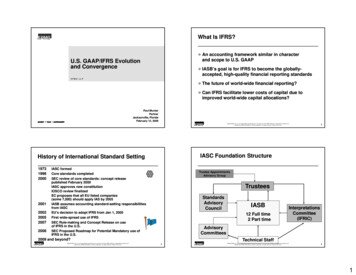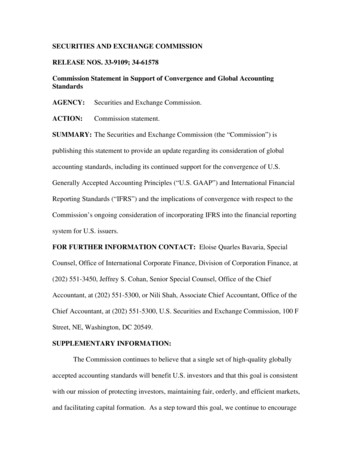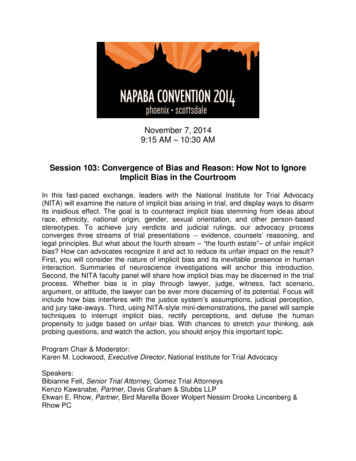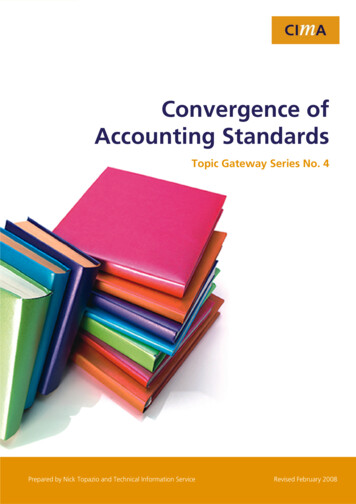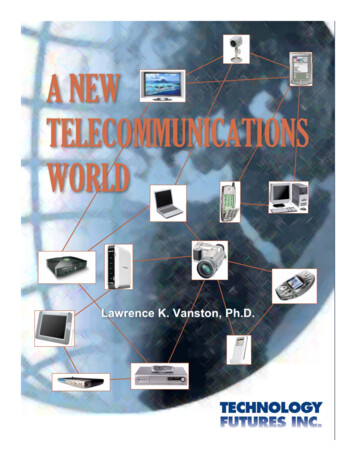
Transcription
Why Convergence between the FASB and IASB May Be ImpossibleByFrancesco De LucaAssociate ProfessorDepartment of Business AdministrationUniversity “G. d’Annunzio”Viale Pindaro, 42 – 65127 PESCARA – ITALYPhone: 390854537609fdeluca@unich.itandJenice Prather-KinseyProfessor and Sallie W. Dean ScholarDepartment of Accounting and FinanceSchool of BusinessUniversity of Alabama at BirminghamBirmingham, AL 35294 USAPhone: 205-934-8828prahterkinsey@uab.edu1
Why Convergence between the FASB and IASB May Be ImpossibleAbstractThe objective of this study is to present not only the similarities, but differences in theorganization structure, standard setting process and political/business environments betweenthe FASB and IASB. This exposition provides a partial explanation of why convergencebetween these two regulatory bodies may be impossible. We show how these differences andthe influence of their political, business and legal environments impede convergence.Moreover, we provide some examples of how political and regulatory bodies have influencedoutcomes of the standard setting process both in the U.S. and in Europe. Accountingpractitioners and regulatory bodies may be interested in this study in explaining the barriersto accounting convergence. For example, students of accounting in many instances are notexposed to the political and legal interplay of accounting and how it differs betweencountries. Others are not aware of how local jurisdictions, political, and legal structures effectthe development of accounting standards.2
Why Convergence between the FASB and IASB May Be Impossible1. Introduction and outlineThe objective of this study is to present not only the similarities, but differences in theorganization structure, standard setting process and political/business environment betweenthe FASB and IASB. This may partially explain the convergence issues between these tworegulatory bodies. Most studies focus on the empirical results of comparability, usefulnessand cost of capital differences in applying U.S. GAAP and IFRS. Other studies find thatlegal origin, market infrastructure, and culture explain these differences in financial reportingand regulation (Ball, Robin and Wu 2003). Still other studies explain differences in theconceptual frameworks between the FASB and IASB as an explanation for differences infinancial reporting (Zeff 2002). We present a commentary on the FASB’s and IASB’sstandard setting, due process and regulatory environments as a partial explanation for whyconvergence between the IASB and FASB may be impossible.We believe that accounting practitioners and regulatory bodies may be interested in thisstudy in explaining the impediments to accounting convergence. For example, students ofaccounting in many instances are not exposed to the political and legal interplay ofaccounting standard setting and how it differs between countries. Others are not aware ofhow much influence local jurisdictions or political and legal structures effect the developmentof accounting standards.We believe that there are many similarities between the FASB’sand IASB’s organization structure but there are overwhelming differences also. Moreover,we show how these differences hinder the convergence of accounting standards, de jure andde facto, between the IASB and FASB. First we present the organization structures of theseBoards.Next we present their due process.Finally, we show how dissimilarities inorganization structure and due process and the influence of their political, business and legalenvironments impede convergence.3
2. Organization Structure of the IASBThe International Accounting Standards Committee (IASC) was founded in 1973 with themajor aim of developing a single set of high quality standards with specific requirements ofproviding for fewer alternative practices, clarity in its standards1, and comprehensiveness2and transparency of information3. These objectives have been undertaken by the InternationalFinancial Reporting Standards (IFRS) Foundation since 2001.It is composed by 22Trustees4, who are also responsible for safeguarding the independence of the IASB andensuring the financing of the organization. The IASB is the independent standard-settingbody of the IFRS Foundation and since 2012, it is made up of 16 full-time members who areresponsible for the development and publication of IFRSs and for approving Interpretationsof IFRSs as developed by the IFRS Interpretations Committee (formerly called the IFRIC)(see figure 15)– Insert Figure 1 –In order to establish its high quality standards, the IASB follows an open and transparentdue process based on the publication of consultative documents, such as discussion papersand exposure drafts, for public comment. This approach allows the IASB to take into accountcomments from stakeholders around the world, including investors, analysts, regulators,1To avoid difficulties in interpretation.2In order to provide a solution for every kind of operation that a company could face, being able at the sametime to provide an effective system to assess new kind of transactions.3That means full disclosure and understandability.4Six of the Trustees must be selected from the Asia/Oceania region, six from Europe, six from North America,one from Africa, one from South America and two from the rest of the world.5Source: 3/Who-We-Are-English-2013.pdf (downloaded2/25/2013).4
business leaders, accounting standard-setters and the accountancy profession. A technicalstaff, that comprises accounting professionals, supports the IASB in preparing its technicaldocuments and standards.At the top of Figure 1 in the IASB’s organization structure is the IFRS FoundationMonitoring Board. This Board was established to ensure that the Trustees discharge theirresponsibilities as defined by the IFRS Foundation Constitution, and to approve theappointment or reappointment of IFRS Foundations Trustees. The Monitoring Board iscomposed of members from the Emerging Markets and Technical Committees of theInternational Organization of Securities Commissions (IOSCO), the European Commission(EC), the Financial Services Agency of Japan (JFSA), and the U.S. Securities and ExchangeCommission (SEC). The Monitoring Board includes as an observer, the Basel Committee onBanking Supervision.Since 2001 the IFRS Interpretations Committee, composed of 14 voting membersappointed by the Trustees and drawn from a variety of countries and professionalbackgrounds, has taken the place of the former Standing Interpretations Committee inreviewing on a timely basis widespread accounting issues that have arisen within the contextof current IFRSs and to provide authoritative guidance (IFRICs) on those issues. TheInterpretation Committee meetings adopt the same approach of the IASB in its due processfor developing IFRSs.The IASB Organization Structure has an Advisory Council that provides input/advice onthe IASB’s agenda, standard setting projects and related matters. Like the IASB, the FASBhas an organization structure that is intended to foster independent and transparent standardsetting.5
3. Organization Structure of the FASB– Insert Figure 2 –The Financial Accounting Standards Board’s (FASB’s) organization structure includes theSecurities and Exchange Commission (SEC), the Public Company Accounting OversightBoard (PCAOB) the Financial Accounting Foundation (FAF), the Financial AccountingStandards Board (FASB), The Financial Accounting Standards Advisory Council (FASAC),the Emerging Issues Task Force, the Private Company Council (PCC) and FASB Staff (seefigure 2).The SEC’s mission is to “protect investors, maintain fair, orderly, and efficient markets,and facilitate capital formation” (SEC 2013). The SEC includes five presidentially-appointedcommissioners headquartered in Washington, DC. The Securities Act of 1933 requires thatinvestors receive financial reports that fairly represent the companies registered with theS
Why Convergence between the FASB and IASB May Be Impossible By Francesco De Luca Associate Professor Department of Business Administration University "G. d'Annunzio" Viale Pindaro, 42 - 65127 PESCARA - ITALY Phone: 390854537609 fdeluca@unich.it and Jenice Prather-Kinsey


